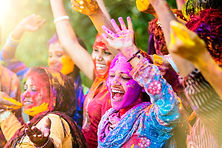Expressive arts

According to the report on Psychology Today, "Expressive arts therapy combines psychology and the creative process to promote emotional growth and healing. This multi-arts, or intermodal, approach to psychotherapy and counseling uses our inborn desire to create—be it music, theater, poetry, dance, or other artistic form—as a therapeutic tool to help initiate change. The difference between expressive arts therapy and art therapy is that expressive arts therapy draws from a variety of art forms, while art therapy tends to be based on one particular art form."
Art assist with those who have suffered from PTSD, domestic violence, sexual abuse, foster children, and many other traumatic experiences.
Forms of expressive art treatment:
-
Art (painting, clay)
-
Dance
-
Yoga
-
Spoken word
-
Equestrian treatment
-
Music
-
Capoeira etc....
Culture

According to the report on the American Psychology Association, "Minorities are less likely than whites to receive needed mental health care, and the quality of care they do get tends to be less than good, says a Surgeon General report unveiled at APA's 2001 Annual Convention. The report, Mental Health: Culture, Race and Ethnicity, is a supplement to Mental Health: A Report of the Surgeon General, released in 1999."
Testimony
My name is LaRone Murphy Sr. I am a father of three biological sons and two stepsons. Approximately three years ago, my life changed, and I found myself stuck. My boys were doing excellent. My job was awesome. The decision to relocate to South Carolina from Michigan was a blessing. But... my marriage was quickly dissolving. It was spiraling out of control, and I had no idea what to do to "fix-it".
As each day passed, my trust dwindled and my patience grew thin.. My wife and I did not argue often, but there was a lot of tension in the air. Communication became difficult for her and I... and I attempted to maintain my "husbandly duties" as best I could.
We decided to separate and get a divorce.
Dr. Angelic Muhammad was my saving grace throughout my transition from married man to single father. I had so much bitterness, animosity and hatred towards my soon-to-be-ex-wife, I could not even look at her face. I did not communicate verbally at all. And my text messages only concerned our youngest child. I spoke with several marriage counselors throughout my marriage and attended a few seminars. My optimism was quickly diminishing as my counseling sessions became useless. No one was able to assist me... except for Dr. Angelic Muhammad.
Dr. Muhammad not only listened to my situation... she internalized it. She helped me to understand a very important fact. Divorce does not equate to failure. Divorce is sometimes needed. And loving myself is just as important as loving my wife, children, etc. We had numerous phone consultations, and a few one-to-one sessions. I specifically remember a conversation we had concerning my future. We didn't talk about a strategy for my future.. no... we talked about how the decisions I make now will directly affect the outcome of my future. I began to embrace my situation. I began to heal.
Today, I am a completely happy. My boys are doing awesome, and I have a cordial relationship with my ex-wife. Dr. Muhammad helped me a great deal and I cannot thank her enough.
LaRone Murphy Sr.
Aeronautical Manufacturing Program Coordinator




Rape Culture & Statics
According to the report on word press

-
1 in 3 (33%) women are survivors of sexual violence or intimate partner violence. (WHO) This figure is actually low when encompassing all forms of sexual violence, including physical sexual harassment and, what many would consider, innocuous assault, like having your ass slapped, bra-strap snapped, or “copping a feel,” especially during adolescence. Those things do fall on the sexual assault spectrum, and they are traumatizing to varying degrees depending on the situation and individual. Bottom line, they are unwanted, nonconsensual sexual contact. The 1 in 3 I often quote, then, is quite low, as I have yet to meet a woman who hasn’t experience some kind of groping in her life. 1 in 6 women are victims of rape or attempted rape at some point in their lives. For the most current rape statistics, read these: RAINN Statistics & Rape Trauma Services Statistics, also read more on The Rape Spectrum
-
1 in 6 (17%) men are victims of sexual violence. Similar to above. The figure most often seen when calculating the number of men sexually abused or assaulted in their lifetime. (Source in Canada) (Source in US and Canada)
-
600 people are raped every day in the USA, one every two minutes. (RAINN)
-
1 in 3 (30-35%) of men would rape if they knew they’d get away with it. (Source. Plus, second source 11 years later showing the same percentage: Kilpatrick)
-
1 in 6 or 7 (14-16%) reported cases will ever see the inside of a courtroom. This was a figure given to me by my own sexual assault attorney back in 2012. I took his word for it, especially after all the research I did coupled with my own experience with the police, as well as experiences like this
-
1 in 16 (6.5%) men are rapists. 2002 Lisak study, although other studies show as high as nearly 15%, or 1 in 7 men.
-
Only 27% whose assault met the legal definition of rape consider themselves rape victims, so great is the minimization and normalization of sexual assault in our society. (Source)
-
Only 40% of rapes are reported to the police. (RAINN)
-
There’s a 50% chance a person will develop PTSD after rape. (Source)
-
Between 60% and 99% of rapes and sexual assault are perpetrated by men onto women, children, other men, and transgender people. (Source) Please stop shouting “women rape too” as a derailed when the discussion defaults to the male pronoun as perpetrator. Yes, they do, and they account for between 1% – 40% of the rapes perpetrated. Important to remember, and it’s also important to validate those survivors who were raped by a woman. For more information, please read my disclaimer page.
-
Between 65% and 85% of rapes are perpetrated by someone the victim knows. (Source)
-
91% of victims of rape/sexual assault are female and 9% are male. (Source)
-
97% of rapists will never spend even a single day in jail. (RAINN)
-
98% of reported rapes are true, only 2% are false, which is lower than false reports in every other type of crime. In fact, the 2% is a little high. The actual statistic is 1.5%, and I’ve seen it stated as low as 0.7%, which in my experience is the most accurate. The FBI quotes 8% false, but read this article to see why I choose the lower percentage. Since cries of “false accusation!” are the greatest of The Great Derailers, please read a more comprehensive explanation on my Derailers: False Accusations page.
Probably the most comprehensive, sobering, and well-known studies are David Lisak’s findings, which is the basis for the excellent Yes Means Yes post “Meet the Predators,” and the recent United Nations study on the roots of sexual violence spanning six countries and two years. This latter study shows, worldwide, a whopping 25% of men (1 in 4) had raped someone in their lives. 1 in 10 (10%) had raped someone who wasn’t their partner.
It’s so easy to dismiss the UN’s findings by saying those happened somewhere other than the USA, but the Lisak study and the Harvard study, as well as the RAINN statistics, speak solely about US culture and US men. Because this mentality, unfortunately, is international:
